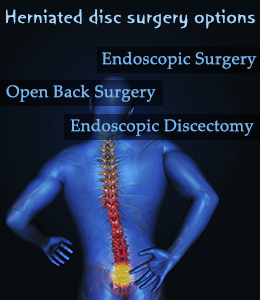Discectomy or herniated disc surgery is a surgery that is performed to remove a herniated spinal canal disc. The surgery becomes essential when the spinal canal is affected due to a fragment of the normal disc getting dislodged.

The excruciating pain that accompanies the dislodging of a disc of the spinal canal is not something that can be put into words. Most patients with the irregularity opt for herniated disc surgery. The urgency arises out of the fragment of dislodged disc pressing against the spinal cord. Many a time, it even stresses nerves that surround the spinal cord. The pressure exerted leads to the manifestation of symptoms like back and leg pain and weakness of muscles.
Causes of Herniated Disc
A herniated disc is the result of a shift in the 'cushion' that occupies the space between the spinal vertebrae. When this gets pushed out of its normal position, it is diagnosed as a herniated disc. Spinal discs have nerves located very close to the edges. When, with age, the spinal disc becomes less elastic, it ruptures. The herniated disc bulge pinches the spinal nerves and spinal cord. Any kind of pressure or stress to these nerves or shift in position of the sensitively located disc develops the need to consider herniated disc surgery. The condition could be the outcome of a nasty fall or an accident. It is also observed in the case of repetitive and neglected straining on the spine. A previous condition of stenosis of spine also results in a herniated disc.
Preliminary Tests
The herniated disc surgery involves a number of preliminary tests to determine the extent to which the spinal disc is dislodged. Clinical research helps to find out more about the rigidity of the region that sets in with age. The MRI scan is conducted to display evidence of disc deterioration. Though it is a condition that is normally seen in aged people, patients as young as 30 have also been diagnosed with herniated disc.
Symptoms
The symptoms of a herniated spinal disc manifest mainly due to the compression of the spinal nerves. This results in occasional passing through of abnormal signals or no signals at all. The symptoms commonly associated with a herniated disc include:
- Electric shock pains: These are especially experienced when the stress on the nerves occurs in the cervical region and the lumbar. The excruciating pain can be felt in the arms and down the legs.
- Abnormal sensations and muscle weakness: Patients report tingling and sometimes numbness in the limbs. On account of the nerve irritation and subsequent interruption of brain signals, muscle weakness is observed.
If left neglected, the condition could worsen into the Cauda Equina Syndrome. This medical emergency results in problems with urination and bowel movements.
Diagnosis
The diagnosis of a herniated disc involves physical examination. Tests are conducted for measuring sensations, muscle strength and reflexes. An MRI is conducted to highlight the abnormality. The diagnosis and treatment plan largely depend on the results of the physical examination and MRI.
Herniated Disc Surgery Options
The surgical treatment of herniated discs provide the following options.
- Open Back Surgery: The traditional option for treating herniated discs is with open back surgery. This procedure involves gain access to the damaged disc by the way of tearing and cutting of the muscles, tissues, and surrounding structure.
- Endoscopic Surgery: Endoscopic spine surgery is the second option for operating on herniated discs. This procedure uses endoscopes and special surgical tools that require small incision which results in lesser operating time and shorter recovery period.
- Endoscopic Discectomy: A modern technique used to remove damaged disc material that is causing pain but does not involve bone removal, large skin incisions or muscle damage. Instead, endoscopic discectomy utilizes magnified video and x-ray imaging to guide an endoscopic probe into the damaged disc space.
- Endoscopic Foraminotomy: Another option of minimally invasive surgery is endoscopic foraminotomy. This procedure relieves the pressure caused by compression from disc bulges, disc herniation, bone spurs, scar tissue, or excessive ligament development. Due to its minimal invasiveness, recovery time of endoscopic foraminotomy in short and patients resume are able to resume normal activities in no time.
The previous symptoms like leg pain dissipate after a number of weeks, post surgery. Pain around the incision made is natural and controlled with oral medication. Patients are not encouraged to stay in hospital beyond a day. Doctors do recommend the use of a lumbar corset brace sometimes. Recovery from surgery is best when the patient exercises caution in movements after the surgery.


 The excruciating pain that accompanies the dislodging of a disc of the spinal canal is not something that can be put into words. Most patients with the irregularity opt for herniated disc surgery. The urgency arises out of the fragment of dislodged disc pressing against the spinal cord. Many a time, it even stresses nerves that surround the spinal cord. The pressure exerted leads to the manifestation of symptoms like back and leg pain and weakness of muscles.
The excruciating pain that accompanies the dislodging of a disc of the spinal canal is not something that can be put into words. Most patients with the irregularity opt for herniated disc surgery. The urgency arises out of the fragment of dislodged disc pressing against the spinal cord. Many a time, it even stresses nerves that surround the spinal cord. The pressure exerted leads to the manifestation of symptoms like back and leg pain and weakness of muscles.